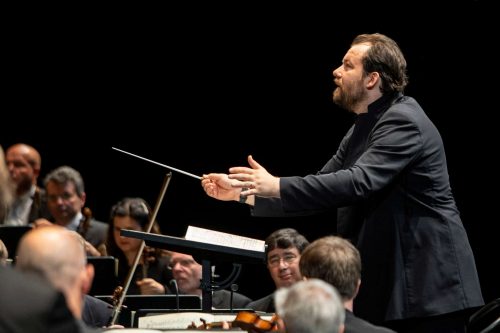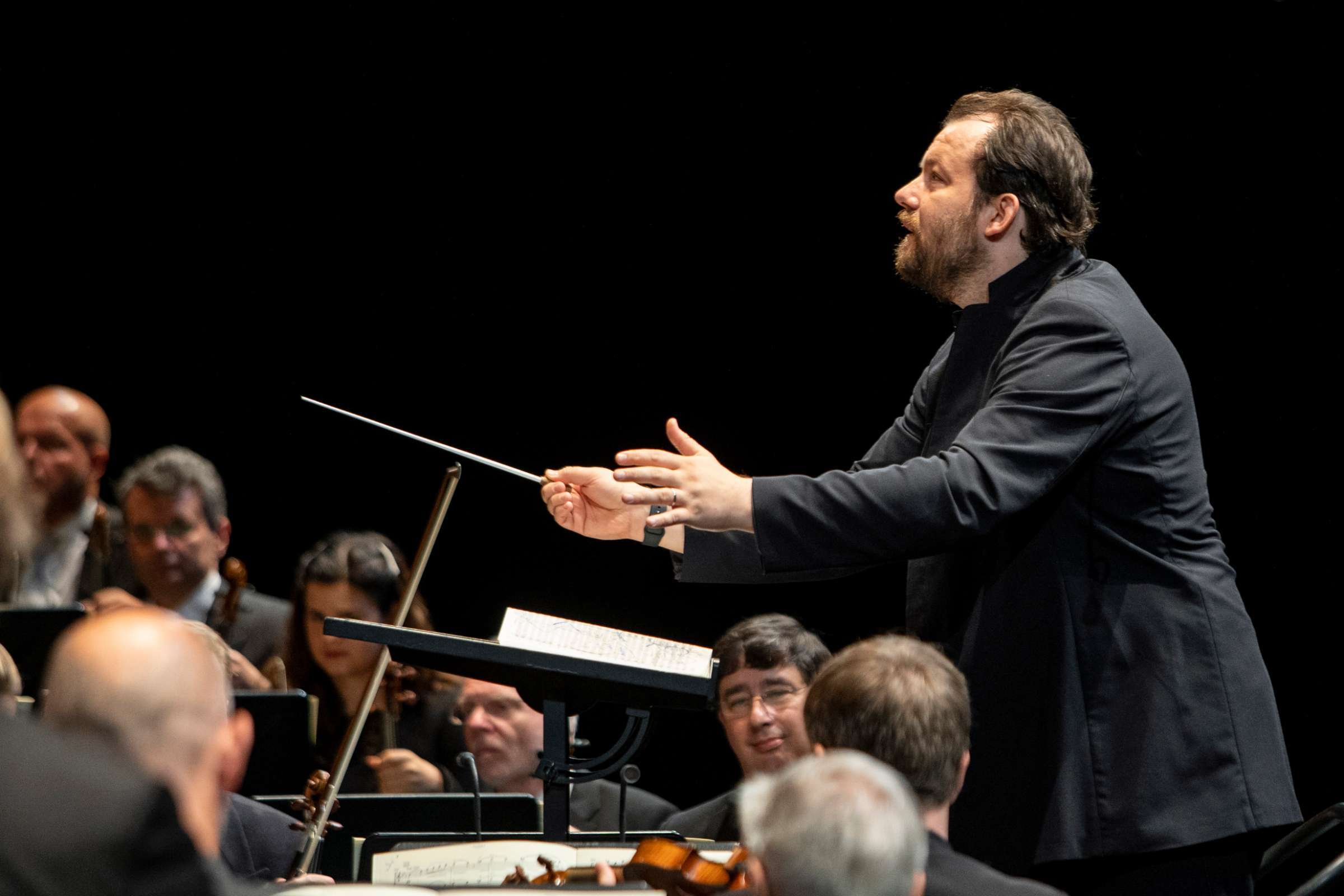
 Austria 100th Salzburg Festival – Mahler: Vienna Philharmonic Orchestra / Andris Nelsons (conductor). Reviewed as an Arte Concert live stream from the Grosses Festspielhaus, Salzburg, 8.8.2020. (JPr)
Austria 100th Salzburg Festival – Mahler: Vienna Philharmonic Orchestra / Andris Nelsons (conductor). Reviewed as an Arte Concert live stream from the Grosses Festspielhaus, Salzburg, 8.8.2020. (JPr)

Mahler – Symphony No.6 in A minor
The last time I saw Andris Nelsons conduct the Vienna Philharmonic Orchestra it was on TV and I was watching their traditional New Year’s Day concert from Vienna. Little did we know then how the world on 1 January would prove to be happier and more carefree than the one we live in barely a few months later. This 100th Salzburg Festival does give cause for some optimism, I suspect all the performers are subjected to health checks and – though we didn’t see the audience in the Grosses Festspielhaus – from the bravos and thunderous ovation at the end many were there. I have read how the Festival authorities have banned those sitting in the theatre from fanning themselves and they have been told to put their masks back on during the applause. Only one member of the orchestra – that I could see – was protected by a face covering. Most importantly – despite having his head in the score – it was clear the rapport between Nelsons and his Viennese musicians that was evident on New Year’s Day permeated through their performance of Mahler’s Sixth Symphony.
As I have written before – and as recently as here – this symphony is burdened with mystery and contradictions. Most significant to we saw and heard from Salzburg was the ongoing controversy about order of the inner movements. To briefly remind readers of the background to this, we begin with the composer’s first thoughts when he put his Scherzo second followed by the Andante as was the prevailing classical practice: slow movement second and a dance movement third. So, the score was first printed Scherzo/Andante (S/A), but when he started conducting it Mahler began to have the Andante first (A/S) and had slips inserted into unsold copies to this effect. This is how it was performed while Mahler was alive, and how his friend Willem Mengelberg performed it with his Concertgebouw Orchestra in 1916. In 1919 he made an unwise move and checked this with Mahler’s widow, Alma, whose brief response was ‘First Scherzo, then Andante’, and that is how Mengelberg conducted it in 1919 and 1920.
Vienna’s International Gustav Mahler Society proclaimed in their 1963 Critical Edition of the Sixth Symphony that this was to be settled as S/A and few argued, though some conductors – such as John Barbirolli – continued with A/S. There was no evidence – that I have been made aware of – that Mahler ever changed his mind about wanting the Andante before the Scherzo and eventually the International Gustav Mahler Society published its revised second thoughts in 2010 along those lines. My own opinion – for what it is worth – is that the symphony has more impact, is more frightening – perhaps more ‘tragic’ (as it was originally nicknamed) — if the Alpine refuge of the Andante comes before the ‘Dance of Death’ (Totentanz) horrors of the Scherzo. Both middle movement orders have their adherents and it is possible to get bogged down in musicological minutiae. The final answer might be as the conductor Benjamin Zander propounded and how there are really two Mahler Sixths; one that was the original conception of Mahler the composer and the one that was the result of the revisions by Mahler the conductor. (Intriguingly, Zander’s own recording with the Philharmonia allows both versions to be played.) As for Andris Nelsons – to my surprise – he opted for S/A as it had been A/S the last time I heard the VPO play Mahler’s Sixth Symphony at the 2017 BBC Proms under Daniel Harding.
The proper judgement of a performance can only really be made by being in the concert hall and hearing it ‘live’. (I have given up hoping for the time when those days will return for me in the UK while the government is currently striving for an improbable germ-free society.) As heard through my laptop speakers the VPO seemed on truly inspired form. Overall, I got the impression Nelsons downplayed most of the ‘tragic’ elements until the very end when it was impossible to ignore the bleakness engendered by the visceral final fff bars in the minor. The rest was more a battle for keeping on living against the vicissitudes life throws at you, and not solely the march of time. So, from 1906 Mahler has bequeathed us the near-perfect musical metaphor for 2020.
Can any orchestra’s basses sound more sepulchral than those of the VPO? There was aggression but this was offset by luminous strings and the inherent sweetness of the woodwinds. The march was not as unremitting as it could be and it was the quieter, more reflective, moments that were the most telling; though it made it even more ominous when the march finally returned and was full of portent with just a small glint of hope shining through all the darkness. However, the Scherzo seemed to suggest this feeling of optimism was a ‘false dawn’ as it set off on a relentless tread, even then, it was more reticent and less demonic than it can sound. The climaxes did not shriek as they might – though that may be because the VPO are incapable of making an ugly sound – and there was some beautiful phrasing in the gentle first trio.
When the Scherzo precedes the Andante, the effect can be to make it all seem rather exhausting, though strangely not so with Nelsons and the VPO. The bittersweet Andante was sensitively phrased, its meltingly beautiful melody and poignant horn calls couldn’t fail to transport even the hardest of hearts to an almost Richard Strauss-like Alpine idyll; especially thanks to the cowbells that I somehow missed in the first movement. The Andante moved at a flowing pace with a plaintive and tranquil warmth from the orchestra.
The tuba intoned balefully, and with woodwind and brass to the fore the Finale began the inexorable trajectory of an emotional musical rollercoaster. The strings were still glowing, yet the harps seem to suggest we are approaching the gates of heaven and the celesta added to a sense of mystery. The more lyrical second subject and the sudden moments of euphoria got punctuated by exclamations of the impending ‘tragedy’. Those who know the symphony well always anticipate what this is building to – yes – the two hammer blows! A huge mallet was wielded to visibly thrilling effect; though listening in online it did not have much aural impact and the sound seemed smothered by the general orchestral crash, bang, and wallop! Still it was wonderful how Nelsons and his magnificent orchestra lulled us into a false sense of expectation that there might be a positive outcome after all (rather like when lockdown was initially eased). Subtly the tension was cranked up such that the symphony’s closing plunge into an abyss of despair was viscerally extremely disturbing.
As ever when the VPO are playing there were too many excellent individual contributions to mention them all. (A highlight of the broadcast – very well directed by Ute Feudel – was watching Nelsons at the end amusingly miming the sections of the orchestra he wanted to stand and receive the audience’s acclaim.) The brass and woodwind excelled in their standout phrases, though it was the revered VPO strings that provided the solid backbone of the performance. Still, it is important to acknowledge the concertmaster, Volkhard Steude, and a hardworking oboist for their solos and ensemble work, as well as, the valiant timpanists and the rest of the percussion.
Jim Pritchard
This concert is available until 6.11.2020 on ARTE Concert click here.
